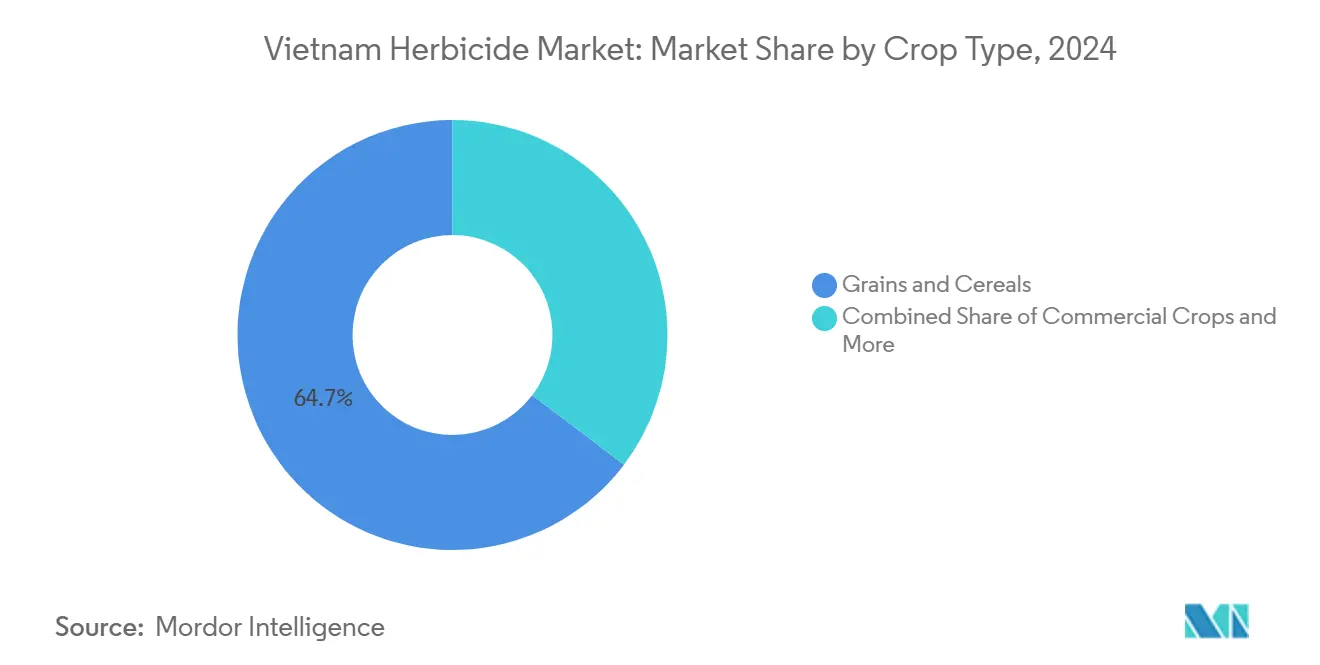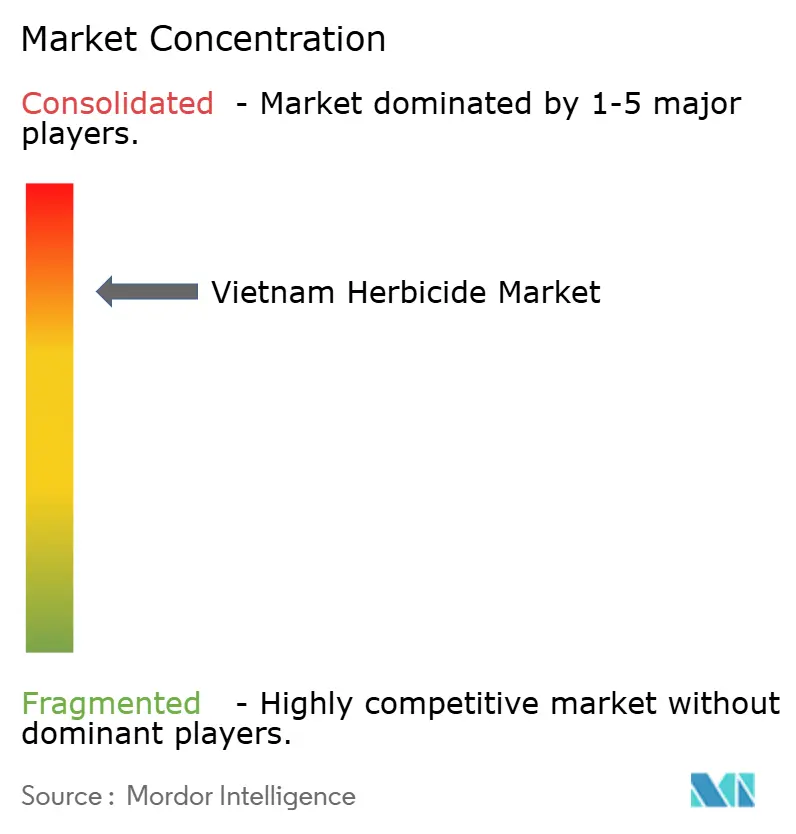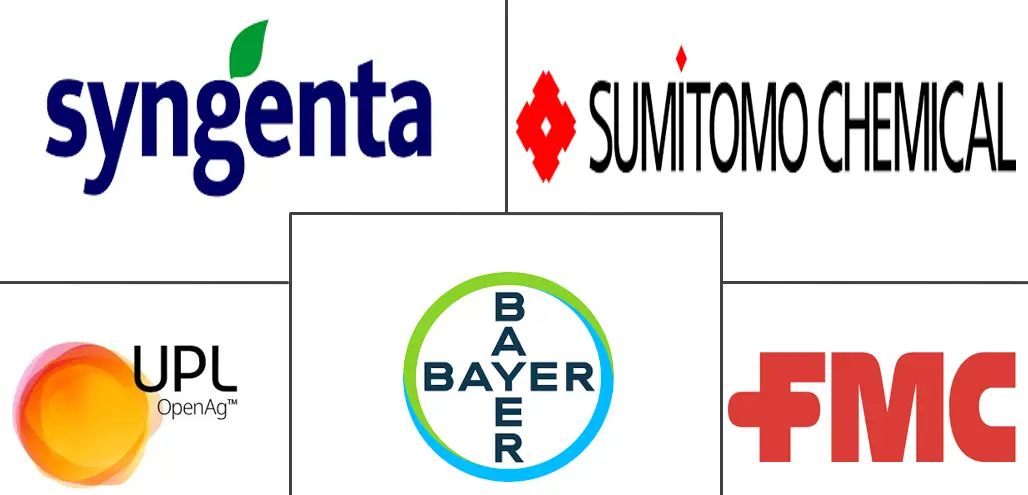Vietnam Herbicide Market Size and Share

Vietnam Herbicide Market Analysis by Mordor Intelligence
The Vietnam herbicide market size is valued at USD 128.16 million in 2025 and is forecast to reach USD 163.08 million by 2030, expanding at a 4.93% CAGR over the period. Growth stems from rising rural wages, mechanized direct-seeding in rice, and rapid uptake of drone-aided spraying, all of which make chemical weed control more cost-effective than manual labor. Regulatory tightening under Circular 03/2025 is steering demand toward newer, selective active ingredients, while expanding ag-input e-commerce lowers purchase barriers for smallholders. Intensifying resistance in Echinochloa crus-galli and growing adoption of glyphosate-tolerant corn varieties further influence product mix and competitive strategy within the Vietnam herbicide market.
Key Report Takeaways
- By application mode, soil treatment captured 46.5% of Vietnam herbicide market share in 2024 and is advancing at a 5.13% CAGR through 2030.
- By crop type, grains and cereals commanded 64.7% of Vietnam herbicide market size in 2024, while fruits and vegetables exhibit the fastest 5.14% CAGR to 2030.
Vietnam Herbicide Market Trends and Insights
Drivers Impact Analysis
| Driver | (~) % Impact on CAGR Forecast | Geographic Relevance | Impact Timeline |
|---|---|---|---|
| Rising labor costs are accelerating chemical weed control adoption | +1.2% | National, with the highest impact in the Mekong Delta and the Red River Delta | Short term (≤ 2 years) |
| Expansion of GM glyphosate-tolerant corn imports | +0.8% | Northern provinces and Central Highlands | Medium term (2-4 years) |
| Government crop-diversification programs for higher-value produce | +0.6% | National, concentrated in fruit-growing provinces | Long term (≥ 4 years) |
| Drone-based ultra-low-volume spraying by agri-cooperatives | +0.5% | Mekong Delta, expanding to the Red River Delta | Medium term (2-4 years) |
| Direct-seeded rice shift boosts pre-emergent herbicide usage | +0.7% | Mekong Delta rice-growing regions | Short term (≤ 2 years) |
| Growth of ag-input e-commerce delivering small herbicide packs | +0.4% | National, with urban-adjacent farming areas leading | Medium term (2-4 years) |
| Source: Mordor Intelligence | |||
Rising Labor Costs Accelerating Chemical Weed Control Adoption
Vietnam's agricultural sector faces acute labor shortages as rural workers migrate to urban manufacturing centers, driving daily farm wages up annually across key production regions. This labor scarcity particularly impacts rice cultivation, where manual weeding traditionally required 15-20 person-days per hectare during peak growing seasons. Mechanized direct seeding adoption addresses this challenge by shifting weed management from labor-intensive manual weeding to herbicide-dependent systems, with pre-emergent applications becoming essential for crop establishment. Resulting savings reinforce the Vietnam herbicide market’s momentum, especially for pre-emergent soil treatments.
Expansion of GM Glyphosate-Tolerant Corn Imports
Vietnam's cautious approach to genetically modified crop adoption creates strategic opportunities for herbicide market expansion, particularly as the country recognizes only 31 GM maize varieties, with 6 classified as biosafe for cultivation. This limited GM adoption contrasts sharply with regional neighbors, yet creates a controlled environment for evaluating glyphosate-tolerant systems in corn production areas spanning northern provinces and the Central Highlands. The Ministry of Agriculture and Rural Development's gradual approval process for GM varieties signals potential expansion of glyphosate-compatible cropping systems, though adoption rates remain constrained by farmer education and seed availability[1]Source: General Statistics Office of Vietnam, “Socio-economic situation report in October and 10 months of 2024,” gso.gov.vn .
Government Crop-Diversification Programs for Higher-Value Produce
Vietnam's agricultural policy prioritizes crop diversification toward high-value fruits and vegetables, with government programs targeting export markets that demand stringent residue compliance and traceability standards. This diversification strategy drives herbicide demand in perennial crop systems, where selective products enable weed control without compromising fruit quality or certification requirements. The shift toward premium produce creates demand for herbicides compatible with organic certification programs and integrated pest management systems, as farmers seek to capture price premiums in international markets.
Drone-Based Ultra-Low-Volume Spraying by Agri-Cooperatives
Agricultural cooperatives rapidly adopt drone spraying technology as a service-based model that addresses both labor shortages and precision application requirements across Vietnam's fragmented farm structure. Hanoi allocated VND 11 billion (USD 445 million) for drone spraying trials during 2024-2025, while the Mekong Delta deployed thousands of operational units by 2024, representing a dramatic scaling from pilot programs[2]Source: Food and Agriculture Organization of the United Nations, “Drone technology enhancing rice farming in Viet Nam,” fao.org. The cooperative service model enables smallholder farmers to access precision spraying technology without capital investment, driving herbicide demand toward products optimized for aerial application and reduced drift characteristics.
Restraints Impact Analysis
| Restraint | (~) % Impact on CAGR Forecast | Geographic Relevance | Impact Timeline |
|---|---|---|---|
| Tightening paraquat and glyphosate registration rules | -0.9% | National, with the strongest impact on rice-growing regions | Short term (≤ 2 years) |
| Consumer push for residue-free produce and organic labels | -0.6% | Export-oriented production areas, fruit and vegetable regions | Medium term (2-4 years) |
| Herbicide-resistant Echinochloa crus-galli biotypes in Mekong Delta | -0.4% | Mekong Delta rice production areas | Long term (≥ 4 years) |
| Highly fragmented land holdings hindering service-based spraying | -0.3% | National, most pronounced in northern provinces | Long term (≥ 4 years) |
| Source: Mordor Intelligence | |||
Tightening Paraquat and Glyphosate Registration Rules
Vietnam's regulatory framework increasingly restricts broad-spectrum herbicides, with paraquat banned and glyphosate facing mounting scrutiny through revised maximum residue limits and application restrictions. The Ministry of Agriculture and Rural Development's Circular 03/2025 adds 32 herbicide active ingredients to restricted lists, while the new Plant Protection and Quarantine Law, effective January 1, 2025, strengthens enforcement mechanisms for chemical compliance. These regulatory changes force farmers to adopt more selective, often more expensive herbicide alternatives, while creating market opportunities for companies developing novel modes of action. Japan's recent proposal for Vietnam to revise maximum residue limits for several agricultural chemicals demonstrates international pressure for stricter standards, particularly affecting export-oriented production.
Consumer Push for Residue-Free Produce and Organic Labels
Export market demands for residue-free produce create downward pressure on herbicide usage, particularly as Vietnam received 114 food safety warnings in 2024 for pesticide residues from international buyers. This consumer-driven trend toward organic certification and reduced chemical inputs affects premium fruit and vegetable segments, where price premiums justify additional labor costs for manual weed control or mechanical cultivation. The tension between export competitiveness and chemical reduction creates market segmentation, where premium producers adopt integrated pest management systems while commodity producers maintain conventional herbicide programs.
Segment Analysis
By Application Mode: Soil Treatment Leads the Transition to Mechanization
Soil treatments generated the largest slice of the Vietnam herbicide market size and accounted for 46.5% market share in 2024, rising at a 5.13% CAGR through 2030. Mechanized direct seeding multiplies opportunities for residual pre-emergents, especially in rice paddies, where transplanting once suppressed weeds. Foliar sprays retain traction in orchards and vegetables, while chemigation remains niche due to limited irrigation infrastructure. Drone-ready ultra-low-volume foliar products grow swiftly but from a small base. Fumigation stays specialized because of tight regulations.
Momentum behind soil treatments accelerates as laser land leveling and precision nutrient placement bolster uniformity, reducing per-hectare rates and optimizing costs. Parallel growth in drone services encourages the development of granular formulations that dissolve quickly for aerial spreading, broadening choices for growers and intensifying rivalry among suppliers in the Vietnam herbicide market.

Note: Segment shares of all individual segments available upon report purchase
By Crop Type: Rice Anchors Demand While Horticulture Rises Fast
Grains and cereals command 64.7% market share in 2024, with fruits and vegetables emerging as the fastest-growing segment at 5.14% CAGR through 2030, illustrating Vietnam's agricultural diversification strategy toward higher-value production systems. Commercial crops, including coffee, rubber, and tea, require specialized herbicide programs for perennial weed management, while pulses and oilseeds represent smaller but growing segments driven by crop rotation and diversification programs.
Fruits and vegetables display the fastest growth, spurred by fruit exports and provincial incentives for durian, mango, and dragon fruit expansion. This segment demands selective herbicides compatible with export residue requirements and organic certification programs, creating premium pricing opportunities for specialized products. Turf and ornamental applications remain limited but show potential growth as urban development and tourism infrastructure expand, requiring herbicides suitable for landscape maintenance and golf course management in tropical conditions.

Note: Segment shares of all individual segments available upon report purchase
Geography Analysis
Vietnam herbicide market demand clusters in the Mekong Delta and Red River Delta, which together consume about a good share of national volume due to intensive rice and diversified cash crops. The Mekong Delta alone largest share of the country’s rice, and its 1.5 million ha under direct seeding rely heavily on soil-applied pre-emergents. Provincial budgets, including VND 11 billion (USD 445 million) for drone trials, accelerate technology uptake and reinforce premium formulation sales.
Red River Delta farmers adopt drone spraying to manage fragmented plots more efficiently, although smaller farm sizes limit service economics compared with the south. Central Highlands growers focus on perennial crops such as coffee and rubber, favoring post-emergent knock-down products. Northern mountainous provinces cultivate maize and vegetables on steep terrain, where glyphosate-tolerant corn could lift herbicide volumes if approvals widen.
The country's agricultural geography creates distinct herbicide market segments, with coastal provinces focusing on aquaculture-compatible products, mountainous regions requiring steep-terrain application solutions, and delta areas demanding flood-tolerant formulations. Regional market development reflects Vietnam's position as the world's third-largest rice exporter, where production efficiency gains must balance competitiveness with sustainability requirements, creating opportunities for herbicide products that enable reduced application rates while maintaining weed control efficacy.
Competitive Landscape
The Vietnam herbicide market exhibits a consolidated market with multinational corporations maintaining technology leadership while regional players capture market share through cost-competitive formulations and localized distribution networks. Market concentration intensifies through product differentiation strategies, exemplified by Syngenta's April 2025 launch of Baloric 310EC, which claims dual mode of action technology that replaces 3 traditional herbicide applications with a single treatment, addressing labor shortage concerns while reducing farmer exposure risks[3]Source: Syngenta Group, “Syngenta introduces Baloric 310EC,” syngenta.com.
Competition increasingly centers on precision application compatibility, with companies developing formulations optimized for drone spraying systems that achieve a 50% reduction in chemical usage while maintaining efficacy. White-space opportunities emerge in herbicide-resistant weed management solutions, particularly for Echinochloa crus-galli biotypes spreading across the Mekong Delta, where conventional products face declining efficacy.
Regional players like Wynca Group and UPL Limited leverage local distribution and bulk formulations to target price-sensitive segments, whereas service providers bundle herbicides with drone operations and agronomic advice to capture share among smallholders. Circular 03/2025’s tighter registration hurdles favor companies with robust data packages and support post-2025 pipeline differentiation. Resistance management products and drone-optimized concentrates represent emerging battlegrounds as suppliers vie to shape future demand inside the Vietnam herbicide market.
Vietnam Herbicide Industry Leaders
Bayer AG
FMC Corporation
Sumitomo Chemical Co. Ltd
Syngenta Group
UPL Limited
- *Disclaimer: Major Players sorted in no particular order

Recent Industry Developments
- April 2025: Syngenta Vietnam launched Baloric 310EC herbicide at a major conference in Cần Thơ, introducing a dual mode of action technology that claims to replace 3 traditional herbicide applications with a single treatment.
- January 2025: Vietnam's new Plant Protection and Quarantine Law strengthens enforcement mechanisms for agricultural chemical compliance and registration procedures. The law implements stricter approval processes for herbicide products and establishes enhanced monitoring systems for residue compliance in export-oriented agriculture.
- October 2024: CGIAR reported successful scaling of mechanized direct seeding technology in the Mekong River Delta, with official endorsement from Vietnam's Ministry of Agriculture and Rural Development.
Vietnam Herbicide Market Report Scope
Chemigation, Foliar, Fumigation, Soil Treatment are covered as segments by Application Mode. Commercial Crops, Fruits & Vegetables, Grains & Cereals, Pulses & Oilseeds, Turf & Ornamental are covered as segments by Crop Type.| Chemigation |
| Foliar |
| Fumigation |
| Soil Treatment |
| Commercial Crops |
| Fruits & Vegetables |
| Grains & Cereals |
| Pulses & Oilseeds |
| Turf & Ornamental |
| Application Mode | Chemigation |
| Foliar | |
| Fumigation | |
| Soil Treatment | |
| Crop Type | Commercial Crops |
| Fruits & Vegetables | |
| Grains & Cereals | |
| Pulses & Oilseeds | |
| Turf & Ornamental |
Market Definition
- Function - Herbicides are chemicals used to control or prevent weeds from preventing crop growth and yield loss.
- Application Mode - Foliar, Seed Treatment, Soil Treatment, Chemigation, and Fumigation are the different type of application modes through which crop protection chemicals are applied to the crops.
- Crop Type - This represents the consumption of crop protection chemicals by Cereals, Pulses, Oilseeds, Fruits, Vegetables, Turf, and Ornamental crops.
| Keyword | Definition |
|---|---|
| IWM | Integrated weed management (IWM) is an approach to incorporate multiple weed control techniques throughout the growing season to give producers the best opportunity to control problematic weeds. |
| Host | Hosts are the plants that form relationships with beneficial microorganisms and help them colonize. |
| Pathogen | A disease-causing organism. |
| Herbigation | Herbigation is an effective method of applying herbicides through irrigation systems. |
| Maximum residue levels (MRL) | Maximum Residue Limit (MRL) is the maximum allowed limit of pesticide residue in food or feed obtained from plants and animals. |
| IoT | The Internet of Things (IoT) is a network of interconnected devices that connect and exchange data with other IoT devices and the cloud. |
| Herbicide-tolerant varieties (HTVs) | Herbicide-tolerant varieties are plant species that have been genetically engineered to be resistant to herbicides used on crops. |
| Chemigation | Chemigation is a method of applying pesticides to crops through an irrigation system. |
| Crop Protection | Crop protection is a method of protecting crop yields from different pests, including insects, weeds, plant diseases, and others that cause damage to agricultural crops. |
| Seed Treatment | Seed treatment helps to disinfect seeds or seedlings from seed-borne or soil-borne pests. Crop protection chemicals, such as fungicides, insecticides, or nematicides, are commonly used for seed treatment. |
| Fumigation | Fumigation is the application of crop protection chemicals in gaseous form to control pests. |
| Bait | A bait is a food or other material used to lure a pest and kill it through various methods, including poisoning. |
| Contact Fungicide | Contact pesticides prevent crop contamination and combat fungal pathogens. They act on pests (fungi) only when they come in contact with the pests. |
| Systemic Fungicide | A systemic fungicide is a compound taken up by a plant and then translocated within the plant, thus protecting the plant from attack by pathogens. |
| Mass Drug Administration (MDA) | Mass drug administration is the strategy to control or eliminate many neglected tropical diseases. |
| Mollusks | Mollusks are pests that feed on crops, causing crop damage and yield loss. Mollusks include octopi, squid, snails, and slugs. |
| Pre-emergence Herbicide | Preemergence herbicides are a form of chemical weed control that prevents germinated weed seedlings from becoming established. |
| Post-emergence Herbicide | Postemergence herbicides are applied to the agricultural field to control weeds after emergence (germination) of seeds or seedlings. |
| Active Ingredients | Active ingredients are the chemicals in pesticide products that kill, control, or repel pests. |
| United States Department of Agriculture (USDA) | The Department of Agriculture provides leadership on food, agriculture, natural resources, and related issues. |
| Weed Science Society of America (WSSA) | The WSSA, a non-profit professional society, promotes research, education, and extension outreach activities related to weeds. |
| Suspension concentrate | Suspension concentrate (SC) is one of the formulations of crop protection chemicals with solid active ingredients dispersed in water. |
| Wettable powder | A wettable powder (WP) is a powder formulation that forms a suspension when mixed with water prior to spraying. |
| Emulsifiable concentrate | Emulsifiable concentrate (EC) is a concentrated liquid formulation of pesticide that needs to be diluted with water to create a spray solution. |
| Plant-parasitic nematodes | Parasitic Nematodes feed on the roots of crops, causing damage to the roots. These damages allow for easy plant infestation by soil-borne pathogens, which results in crop or yield loss. |
| Australian Weeds Strategy (AWS) | The Australian Weeds Strategy, owned by the Environment and Invasives Committee, provides national guidance on weed management. |
| Weed Science Society of Japan (WSSJ) | WSSJ aims to contribute to the prevention of weed damage and the utilization of weed value by providing the chance for research presentation and information exchange. |
Research Methodology
Mordor Intelligence follows a four-step methodology in all our reports.
- Step-1: Identify Key Variables: In order to build a robust forecasting methodology, the variables and factors identified in Step-1 are tested against available historical market numbers. Through an iterative process, the variables required for market forecast are set and the model is built on the basis of these variables.
- Step-2: Build a Market Model: Market-size estimations for the forecast years are in nominal terms. Inflation is not a part of the pricing, and the average selling price (ASP) is kept constant throughout the forecast period.
- Step-3: Validate and Finalize: In this important step, all market numbers, variables and analyst calls are validated through an extensive network of primary research experts from the market studied. The respondents are selected across levels and functions to generate a holistic picture of the market studied.
- Step-4: Research Outputs: Syndicated Reports, Custom Consulting Assignments, Databases & Subscription Platforms








